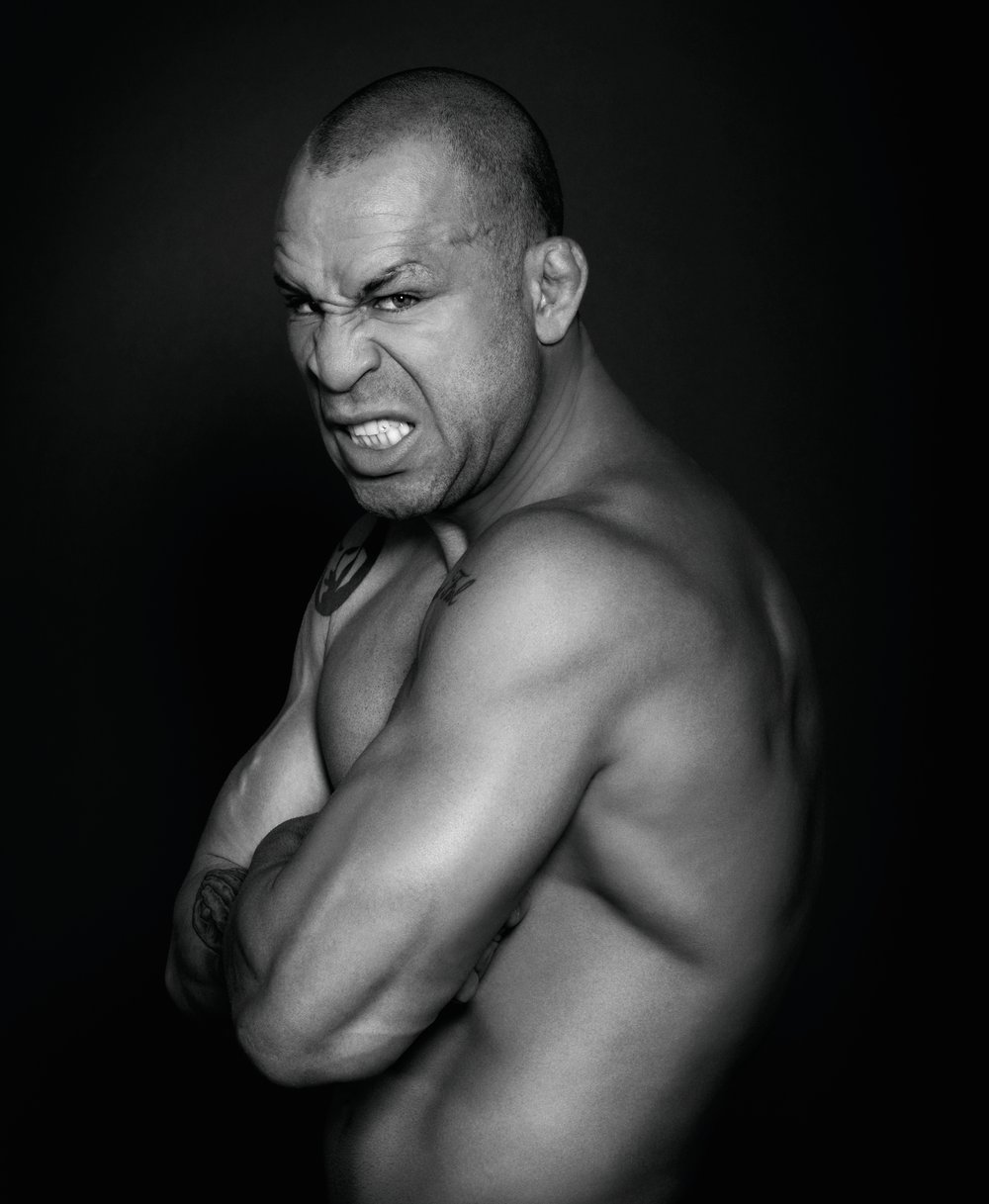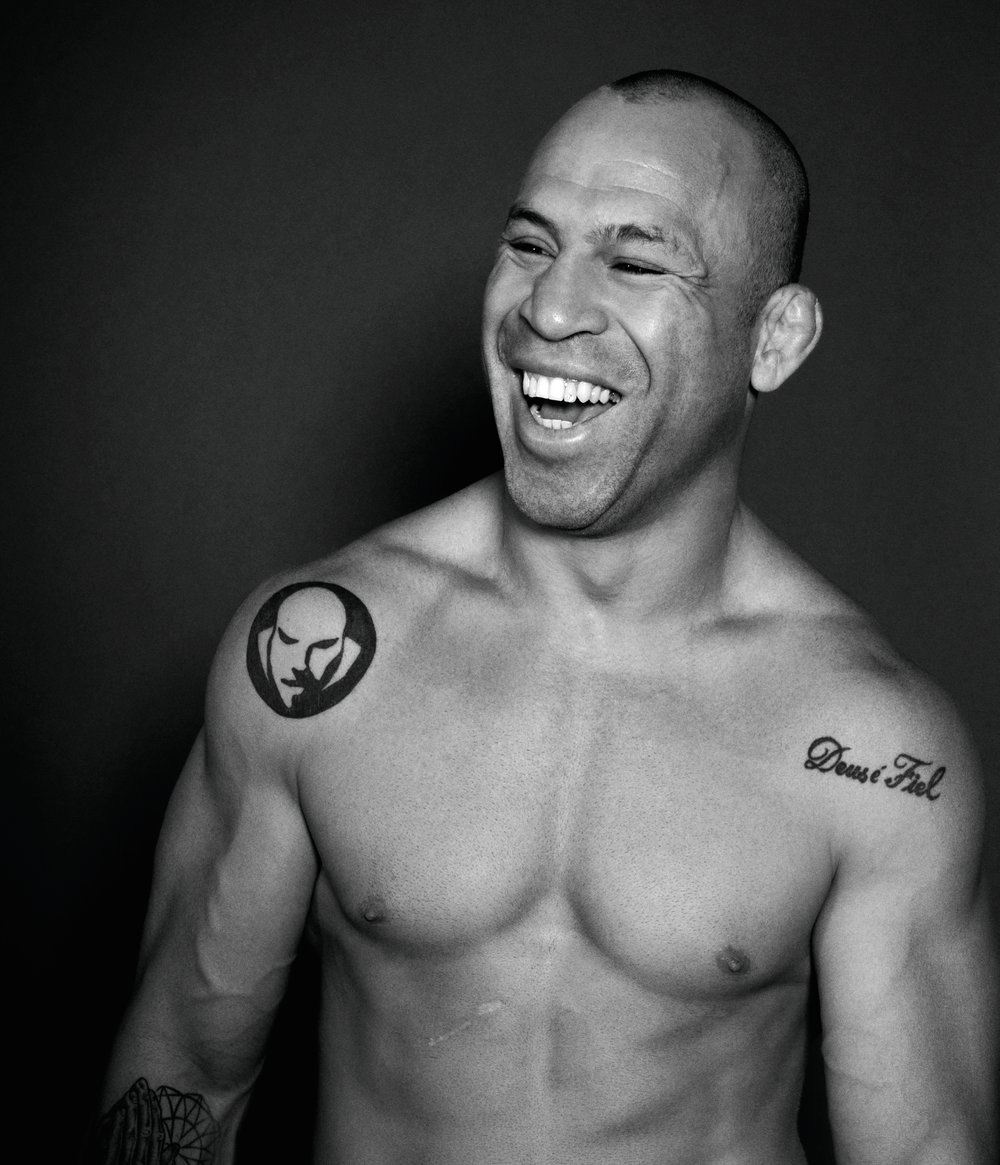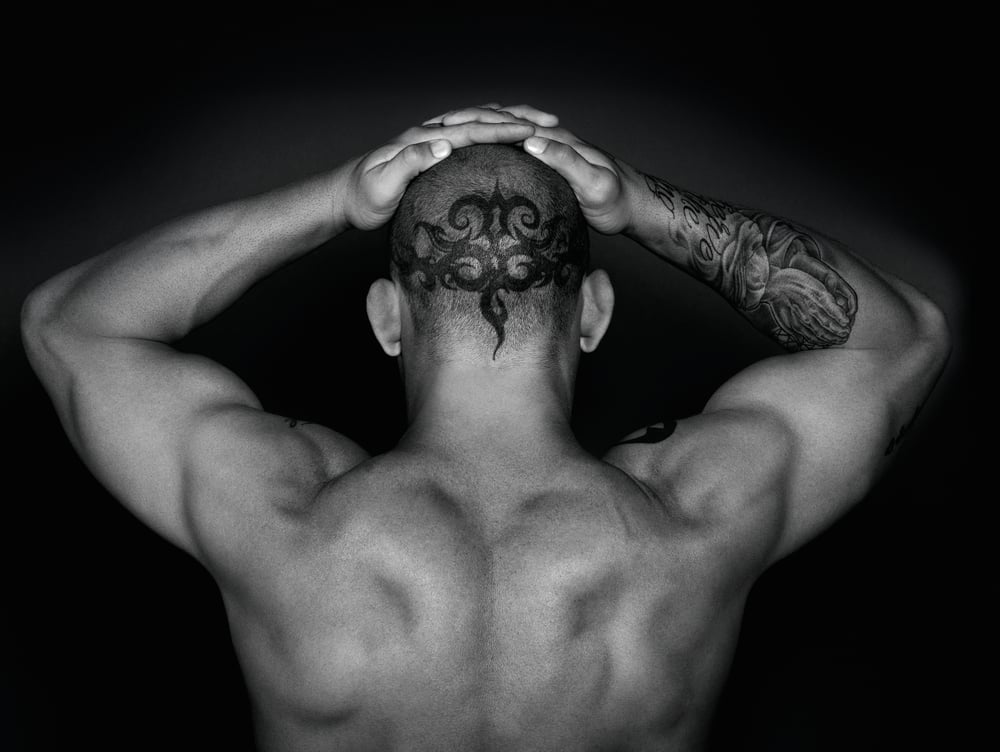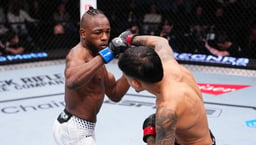
Issue 065
August 2010
Vicious. Brutal. Unforgiving. Wanderlei Silva is one fighter who’s always guaranteed to bring the violence. But there are two sides to this warrior. He boasts strength of character too, as a generous, devout, fan-friendly family man.
Sure, us MMA nuts know about Wanderlei’s rounded personality and intriguing past. But his present and future are just as compelling. A landmark facial reconfiguration. The growth of the Wand fight team. And impressive performances against contenders Rich Franklin and Michael Bisping that’ve triggered a run at the UFC middleweight belt. Fighters Only was granted full and exclusive access to his revitalized camp and found the situation’s far from terminal for the man they call ‘The Axe Murderer’…
Some athletes hold a special place among men. Though we no longer deify them as in ancient times, their acts in the arena sometimes possess a godlike ability to inspire. Sports fans elevate these men to hero status. Their names are revered among aficionados, their exploits chronicled and their actions entered into the history books.
Wanderlei Silva is one such athlete. A professional fighter for 14 years, the battle-scarred Brazilian is a breed apart from his fellow pugilists. His seminal bouts in Japan for the country’s Pride Fighting Championships saw him become the fledgling sport’s first superstar, and led to a high-profile and hardly uneventful UFC run. The mere mention of his name conjures up images of furious action; his career is a non-stop highlight reel of high-octane striking. And it’s not in the can just yet.
After spending the best part of six years fighting almost exclusively for Pride, Silva signed with the UFC light heavyweight division in late 2007. He brought with him a mystique honed in the Japanese ring – this was the former champion, a man who for so long had terrorized opponents with an intensity rarely seen in a professional combatant. His no-mercy approach and go-forward style were risky, but it was guaranteed entertainment, and fans loved him for it. They adored him when he returned to the Octagon for the long-awaited fight with Chuck Liddell, a contest that fans of the once-rival promotions had dreamed of for years.
Much like with Pride in Japan, Wanderlei instantly became one of the UFC’s marquee fighters. Whenever and wherever he fought, legions of fans would flock to see him throw down.
The three syllables of his Christian name are known across the world; in whatever language you speak, ‘Van-der-ley’ sounds the same. Since making the UFC his home, the Brazilian’s status in the sport has changed somewhat. He’s no longer a champion, but he still holds the title of one of the most beloved – and scrutinized – fighters ever to enter a ring or cage.
But as scary as Wanderlei is in the ring, he’s a model citizen in everyday life. He greets almost everyone with a rib-crushing bear hug and a huge smile. When told his time was up at the UFC expo in May, due to the huge line of fans waiting to meet him he shrugged off the suggestion he should leave. He continued to sign autographs for a further two hours, demonstrating why he’s one of the most hallowed MMA fighters of all.
Known as Cachorro Louco (‘Mad Dog’) in Brazil and ‘The Axe Murderer’ elsewhere, you could be forgiven for thinking Silva to be nothing more than a Mike Tyson-esque fighting machine, a primitive brawler focused purely on hurting his opponents. The reality it seems is very different; Wanderlei is a kind and humorous family man who cares deeply about others. The bit about hurting his opponents is true, though.

Building 'Team Wand'
Plenty’s changed for Wanderlei over the years: The move from Pride to the UFC, from Brazil to the USA, opening his new gym. Most noticable is his appearance. Wanderlei’s fresh face is the result of extensive corrective surgery designed to fix the years of wear and tear that professional fighting had wrought upon his visage. Surgeons worked on the heavy scar tissue upon his signature protruding brow line, and totally reconstructed his nose – which was so damaged he couldn’t even breathe out of it. But major changes have also taken place in other areas of his career.
Wanderlei’s relocation from Curitiba, Brazil to Las Vegas saw him leave plenty behind, most visibly his friends, training partners and coaches at the notorious Chute Boxe Academy. With his departure, the team soon fragmented – fellow high-profile representatives such as current UFC light heavyweight champion ‘Shogun’ and his brother ‘Ninja’ Rua formed their own team in the Brazilian city they called home, while the Cyborgs, Cristiane and Evangelista, moved to an affiliate academy in Los Angeles, California. Wanderlei established himself in Sin City.
In 2009 Silva opened his state-of-the-art training facility, Wand Fight Team, located a short ride from Vegas’ Strip. Professional pugilists and MMA fans alike flock there – the fighters for the tough sparring and world-class coaching, the supporters for the chance to meet the legend himself. Wanderlei welcomes them all. “It’s open all the time,” he says. “A lot of guys come here and just take a couple of classes. It’s good to train with different guys. All of my coaches are very professional guys. My team is very friendly, and we enjoy meeting all of our fans from around the world.”
Along with the TapouT Training Center, Xtreme Couture and the Warrior Training Center, Wanderlei’s gym features high on the circuit of Las Vegas gyms that attract migrant fighters. With so many top pros in one city, most split their training across multiple academies and gyms. Even though Wanderlei can have his pick and choose of top-class training partners, he’s busy building a team of up-and-comers currently tearing up the local amateur circuit – fighters such as Jorge Lopez, JJ Mix and Michelle Gutierrez. Along with Vitor Vianna, Jorge Lopez is one of Wanderlei’s main training partners, a hyperactive striker with a penchant for flying knees.
As you might expect, most fighters representing the Wand Fight Team are inclined to throw down – there’s a reason they were drawn there in the first place, after all. Wanderlei can often be seen cornering the members of his team as they kick ass and take names, and the motivation is simple. “Nothing in your life will give you back so much as fighting,” he says. “I had someone believe in me and put me in for a fight. I want to make the same thing for the other guys – this is real, real important. This year we’re going to have a
great year.”
The team’s potential is just a single indicator of the Wand brand’s growth. Another is the opening of an academy on the other side of the US in Pensacola, Florida. “For the first time, I’m opening a second gym,” Wanderlei reports. “Pensacola is a paradisiacal place. I found a lot of fighters there with great potential, that’s the reason why I opened a gym there. We are building a structure there so we can provide all of the athletes in Pensacola with the highest quality of training there is. I want to make my gym in Pensacola a success, just like my gym here in Las Vegas.”

Reinventing 'The Axe Murderer'
The biggest change in Wanderlei’s life is the fact the former light heavyweight marauder now competes in the 185lb division. “It was tough for me to make 205. I had to eat lots of food to get my weight up. It was time to lose it; I think it makes my cardio better. A lot of people asked me what the secret was for me to lose weight. It’s simple: You eat less and run more. I’m sweating more as I train, and the weight is coming off and the cardio is increasing quickly. It was no problem.”
Wanderlei’s debut in the 185lb division was against top English fighter Michael Bisping. They met in the Octagon during the UFC’s first Australian event. The fight was a competitive one, but Silva walked away with a comfortable decision win. This followed a catchweight fight with Rich Franklin at 195lb in June 2009, where Wanderlei was once again used as international ambassador, headlining another of the UFC’s groundbreaking international events, its first in Germany.
Recently, a number of previously dominant fighters found their careers have hit a slippery patch. Chuck Liddell, Randy Couture – MMA superstars who’d once ridden high upon their divisions were exposed as human. Chuck’s career took a dive when he was knocked out four times in six fights. Couture’s weight-class hopping escapades are inspiring, yet his sluggish performances against Vera, Coleman and Nogueira lacked ‘The Natural’s’ seemingly endless vitality.
Through years of study, opponents had identified how to nullify these champions’ strong suits. And Wanderlei was no exception to those high-profile fighters who’d been carefully analyzed and picked apart by the competition. Opponents found gaps in his aggressive all-out style and learned how to counter his advances, much as Rampage Jackson did in their third meeting. He could no longer rely on charging in. “I had to make changes,” Wanderlei himself states. “After I left my other school, in Brazil, I changed everything. I changed my training; I changed the location I live. Now, I’m starting to train like I did before – old school. I take the classes with my students here at Wand Fight Team. I follow the same process as the ones that are just learning. I’m still working on improving the techniques.”
“Techniques are the most important thing he is doing right now,” says Rafael Cordeiro, Wanderlei’s trainer, or ‘professor’ as the Brazilians dub their masters. Cordeiro has been a huge influence upon him since the earliest days of his career. A former Muay Thai fighter and International Vale Tudo (IVC) champion, Cordeiro was a head coach at Chute Boxe until his relocation to the United States in 2008. While Silva decamped to Vegas, Cordeiro headed to Huntington Beach in Los Angeles, opening up his own gym, Kings Muay Thai and MMA. Cordeiro comes to Las Vegas to prepare Silva for his fights, and isn’t shy about describing the former Pride champ’s training practices. “His whole life, he would go to the gym, have a little conversation and train. In the afternoon, he would have a little conversation and train. With this training, he became the Pride champion for five years and IVC champ.”
Cordeiro insists that a return to the basics has been a good thing for Silva. Once well known for fighting with complete abandon, Silva’s new and relatively restrained style is slightly at odds with his reckless brawling of old. This is all part of an ongoing evolution, says Cordeiro: “Techniques are the most important part of success. He’s constantly improving. Against Rich Franklin, he fought better. Against Michael Bisping, he looked even better. He’s slowly growing and getting better.”
With so much of Wanderlei’s technique based around his seemingly unlimited aggression, you might wonder why Cordeiro would wish to try and remove this tried-and-tested method. The answer’s simple. “Everybody is waiting for that,” he states. “They know Wanderlei will come straight forward, so they’ll wait for it. He can still do that in a fight, but he needs to pick the right time for it. He’s the same Wanderlei, the difference is that he’s smarter. He breathes a little bit more, he uses more head movement. The game is different than it was a long time ago – guys didn’t used to study each other so much. Now they know your game and your movements. If you’re fighting Wanderlei, you watch all of his highlights on the Internet, you know he's coming for a war every time.”
Siva’s high-risk strategy of engaging in crowd-pleasing brawls has earned him criticism from analysts, keen to point out that the Brazilian’s willingness to ‘take one to give one’ has led to a slide in his record over the last few years. But Wanderlei himself believes that the reason he throws his game plan out of the arena is due to his desire to put on a good show. “I’m the kind of fighter that likes to stand toe-to-toe. That’s the best show for the fans,” he says. “The fans can cheer for me because I fight that way, but it’s tough. I receive the punches while I give them, that’s why my fights are so emotional. It’s not like Lyoto Machida or Anderson Silva where the guys move so much you can’t touch them. I stand toe-to-toe. I like the exchanges.”
Don’t be fooled by the fan-friendly attitude and all-new studied striking – the same old Wanderlei still bubbles under the surface, just waiting to be let out in the ring. “I have good things inside of me, but I also have inside of me a feeling that I get when I see my opponent. I know how important he is; I know what he's trying to do to me. I’m a professional and inside of the Octagon, I’m going out there and putting everything into it. I might beat him; he might beat me. But I’m not afraid to lose.”

Continuing to inspire
Silva’s years of fighting, a successful clothing brand and string of academies will provide for a comfortable life for his family for many years to come. You might wonder why he continues to fight, but the answer is as stirring as it is straightforward: Wanderlei does it for the fans. “My fans. These guys are my friends. It’s for these guys that I fight,” he says. “I’ve been fighting for 15 years professionally – a lot of guys have followed my entire career and want to watch my fights. I’ve been lucky to give inspiration to people all over the world. I know how special that is, and I know my responsibilities with that.”
Cordeiro elaborates. “A few months ago, he came into my school, Kings MMA, in California. We went out to have a drink before starting camp. An older man with white hair, probably 75 years old or so, he came over to talk to us. He was a very classy-looking guy with nice clothes and dressed in a suit. His eyes were wide open, and he told Wanderlei, ‘I’ve followed you for 15 years.’ Imagine that – he’s 75 years old and has been following Wanderlei for 15 years. The emotion that day was incredible.”
“That’s special. That’s priceless,” says Wanderlei. “Any time I start to feel a little depression before the fight, I can think of this moment. You feel the fight coming up. You have to do all the interviews, film the Countdown show… you feel the responsibility of the moment and you start to think so many things. With everything that’s going on, you start to worry in your mind – it makes you crazy, and you need to be focused for your training, be careful of injuries so you’ll be ready… and all these things are stressful. But that moment when you're walking into the cage, and everyone in the arena is standing up and cheering, you can’t believe how priceless that feeling is; it’s an amazing feeling.”
Wanderlei has some of the most passionate and vocal fans in the world. Anyone who has been in an arena when the opening bars of Darude’s high-energy trance track Sandstorm (Silva’s entrance music for years) starts playing can vouch for the atmosphere. “I have the loudest and craziest fans in the world. Every time I go somewhere new to fight, they are so loud and supportive,” he says. “In Germany, Australia, in Las Vegas, I can feel it – even in the weigh-ins, they’re so supportive. It’s amazing – I don’t have fans, I have friends. Every time I have big lines for my autograph, this is a great honor for me. The guys don’t know how important this is for me; I want to prove to the world not that I’m the best, but I’m the most popular fighter in the world.”
Putting on a good show, the thrill of facing off with a willing opponent – all of these things are important to Wanderlei. But one thing will never change. “I want to win, but I just like fighting; I want to enjoy it. I want to make my fights different than all of the other fighters – that’s why my fans know I give my best every time. If I win or lose, God gives the decision. It’s my job to just do my best in there.” Fans aren’t the only ones who can gain from this do-or-die attitude, as Rafael attests. “It’s great motivation for his students, too. They have an idol in him, and he is a great role model.”

Martial markings
Inking one’s body is often a sign of personal re-invention. The dramatic tribal tattoo etched into the back of Wanderlei’s head is almost as iconic as his terrifying visage. The rest of his many tattoos indicate an individual who places significant weight on his Catholic faith – which could be sweet on anyone else, but just ends up compounding The Axe Murderer’s menace. The Portuguese script across his right forearm reads, “Lord accept my thankful prayer. Teach me your commandments”; and on the left, “For you are my rock and my fortress, my eternal love.” The recognizable text on his left shoulder states, “God is loyal” and is mirrored by the Wand brand logo on his right. Silva’s latest addition continues the theme with, “Serve the King of Kings” below a ‘hands in prayer’ motif on his right forearm.
Wanderlei versus the world
He’s affable and friendly outside the ring, but it’s a different story once the bell rings. Wanderlei has enjoyed some of the most heated rivalries in all of MMA, with two of the sport’s greatest grudge-heavy trilogies.
Kazushi Sakuraba
Wanderlei’s routing of the Japanese legend at Pride 13 didn’t stop Sakuraba from challenging the much-feared Brazilian twice more. Neither of those made it to the judges, but Wanderlei’s clean knockout of Sakuraba in their third meeting was a decisive end to the rivalry. Despite their three encounters there was always great respect between the two – and Saku even visited Chute Boxe in Curitiba once their trilogy was complete.
Dan Henderson
This one may have only lasted for two fights, but the events inside the ring certainly make it memorable. Their 2000 scrap went right to the wire and the rematch seven years later ended with a shocking victory for Hendo in Pride’s penultimate event.
‘Rampage’ Jackson
“I don’t like heem…” The pair’s genuine antipathy made this promotion-straddling rivalry a clash for the ages. Jackson’s efforts in Pride both came to a crashing halt courtesy of Silva’s vicious knees, but the American evened matters with a landmark first-round KO victory at UFC 92.
Chuck Liddell
Perhaps the most significant rivalry in MMA history, the Silva-Liddell debate continued for years while the pair were the dominant, premier knockout artists in their respective homes (Pride for Wanderlei, the UFC for Chuck). They finally met in 2007, and their climactic UFC 79 slugfest was voted the ‘Fight of the Year’ in the 2008 Fighters Only World MMA Awards.

The art of kicking your opponent in the head
Among Wanderlei’s most fearsome weapons during his infamous Pride tenure were The Axe Murderer’s viciously destructive stomps and soccer kicks. Many other Pride competitors used those same tools (perfectly legal in the promotion) but few enjoyed the same success as Silva and his Chute Boxe teammates. The Brazilians mastered these strikes during the country’s vale tudo (‘anything goes’) past. ‘Ninja’ Rua announced himself in Japan with a stomping finish at Pride 16, ‘Shogun’ Rua finished around half of his Pride fights the same way and Wanderlei claimed two wins by introducing his feet to the heads of his downed opponents.
Western audiences take a less enlightened stance on ‘kicking an opponent when he’s down,’ so Wanderlei’s transition to the Unified Rules (as used in the UFC) has seen him leave this portion of his arsenal behind. Some adherents see kicks and knees to the head of a grounded opponent as dangerous and somewhat alarming, while others view the omission of stomps, soccer kicks and knees to the head of a grounded opponent as ‘watering down’ what was once ‘real’ fighting. As Dana White once explained when pressed on the issue, reintroducing the controversial moves would be no easy task. “When the whole world isn’t afraid of this sport anymore, then we can add knees to the head. I like them... but it’s going to take a long time.”
...









